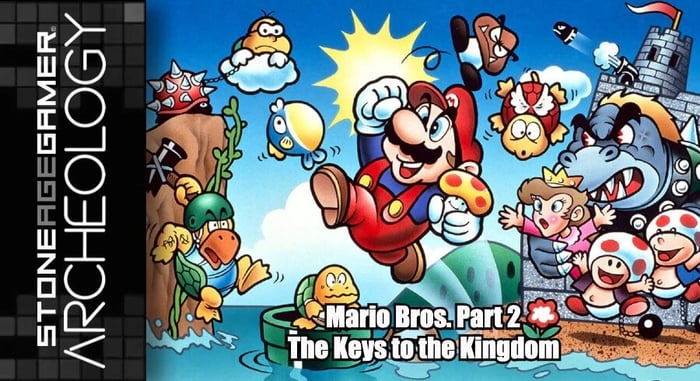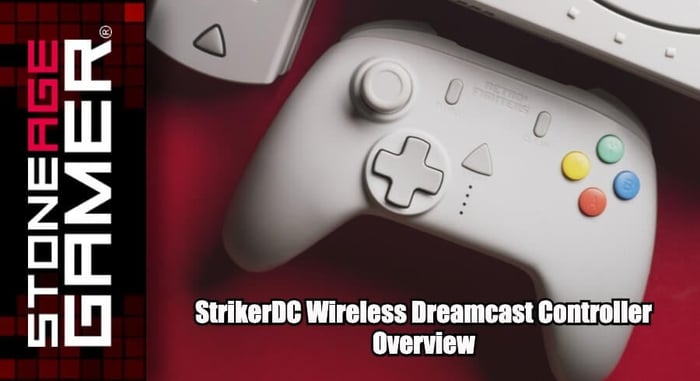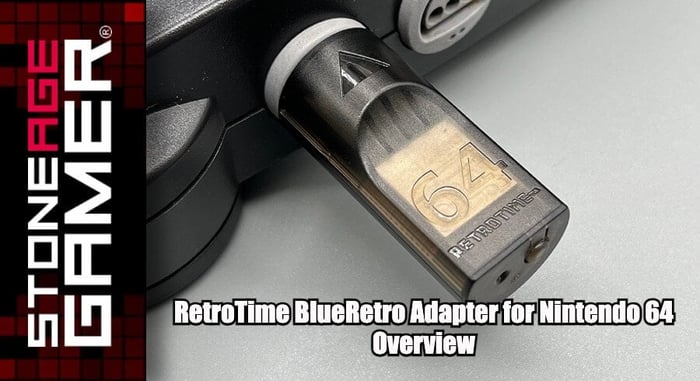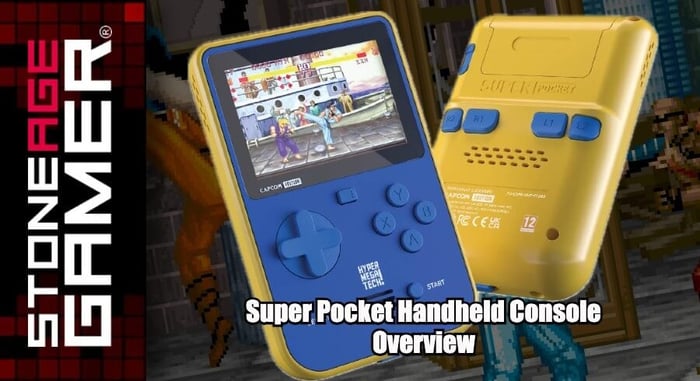
Mario Bros. Retrospective Part 2: The Keys to the Kingdom
Welcome to Part 2 of our Mario Bros. retrospective!
In this episode, we take a look at the Bros. first Super adventure, some bizarre spinoffs, and the timeless tale of two completely different games called Super Mario Bros. 2.
In this series, we aim to tell the story of the Mario Bros. series as it unfolded for North American audiences. That said, this episode delves a bit more deeply into the Japanese side of things because it's impossible to understand the full scope of what was going on with the Mario franchise without looking at what was happening overseas.
But back to the point, we are not only looking at the games themselves, but the historical context surrounding them, and what it was like being a fan as these games were being released.
The music at the beginning of this video is from Atari 50: The Anniversary Celebration and was composed by Bob Baffy. If you're interested in video game history, you should absolutely play that game.
Transcript of the video:

Mario Bros. Retrospective 2
By 1983, video games in North America had become big business. But that same year, things took a turn for the disastrous. Following numerous examples of poor quality control and an oversaturated and under-regulated market, consumer confidence in video games reached an all time low, resulting in the now famous video game crash of 1983. Closeout bins were filled with unsold products, while the biggest names in the industry scrambled to reinvent themselves, or move away from the space entirely.
In Japan though, video games saw no such trouble. Nintendo’s Famicom had been performing extraordinarily well, so much so in fact that Nintendo was ready to take their entry in the video game market to the next level with some brand new hardware, the Famicom Disk System. The Famicom, like most home consoles before it, ran on cartridges, and those carts had limitations. The disk format that the Famicom Disk System add-on promised would allow developers to create games that were far beyond the capabilities of the basic Famicom hardware, and those games would indeed change the landscape forever. But before moving on to this monumental new platform, Shigeru Miyamoto and his team set out to bid the old Famicom the fondest of all possible farewells. They aimed to create the ultimate cartridge game, utilizing every trick in the book to showcase the absolute best the original Famicom was capable of in the form of a sequel to their arcade hit, Mario Bros.
To say that the game was a massive success in its home country would be an understatement. But even so, bringing that success to North America would prove problematic.
With the US video game market crash still in full swing, retailers couldn’t have been less interested in carrying a brand new video game console. If Nintendo was going to get the Famicom in front of North American consumers, they were going to have to devise an unconventional strategy.
The system was redesigned to look more like a modern VCR, with the cartridges being enlarged to function with the new front loading concept. The yellows and maroons were replaced with more sleek grays and reds, and the console was rebranded from the Family Computer to the more futuristic sounding Nintendo Entertainment System. And in a final genius bid to appeal to toy stores, Nintendo marketed the system as a means to control the real star of the show, ROB. The Robotic Operating Buddy, would use the NES and its accompanying cartridges to interact with the television to play rudimentary games. This was all very flashy and impressive looking at a glance, and it did exactly what it set out to do, it got NES consoles into toy stores. But this was all an elaborate ruse. ROB merely opened the door for Nintendo’s true plan. Get their new Mario game into people's homes.
Though exact release dates from this era are notoriously difficult to pin down, the generally accepted approximation is that Super Mario Bros. was released in October 1985, as part of the Nintendo Entertainment System’s limited initial release. While various ads and marketing material focused on ROB as the system’s selling point, it didn’t take long for word to spread that the real reason to purchase Nintendo’s machine was Super Mario Bros. Other games launched with the NES in North America, but none of them could hold a candle to the sheer spectacle that was Mario’s latest adventure.
Where Mario Bros featured an infinitely looping 22 single screen “phases”, Super Mario Bros. contained a whopping 32 fully realized levels, complete with multiple scrolling screens, branching paths, and unique environments. Super Mario Bros. was far from the first side-scrolling platformer, but it was among the first to play this seamlessly on a home console, a fact that quickly wowed audiences.
This time around, Mario and Luigi were still plumbers, but instead of clearing out sewers, they now found themselves in a magical fantasyland called the Mushroom Kingdom. A vile sorcerer named Bowser, the King of the Koopa, had kidnapped Princess Toadstool and used his dark magic to transform the denizens of the Mushroom Kingdom into stones, bricks, and various plants. With Princess Toadstool being the only person powerful enough to reverse Bowser’s evil spell, Mario and Luigi set out to rescue her, and return peace to the Mushroom Kingdom.
Like Mario Bros., Super Mario Bros. was once again a game that placed its focus on jumping, only this time the physics had been refined even further. Mario could now jump at more angles, and even gained a degree of control over himself while in midair. Enemies could still be knocked over when punching the ground beneath them, but they could also be stomped on, and instead of turtle shells falling off the bottom of the screen when kicked, they would now slide across the ground eliminating other enemies along the way. Coins made their return too, but now they floated in the air and collecting 100 of them would net Mario an extra life. But the biggest change to the game came in the form of its objective.
Defeating all of the enemies in a stage was no longer a requirement to finish a level. Instead, the stages themselves were structured more like obstacle courses, where reaching a flagpole at the end triggered the stage’s completion.
A new powerup system was also implemented where Mario could grab special mushrooms to turn him into Super Mario which granted him the ability to break bricks, doubled his size, and allowed him to survive a single hit from an enemy. He could also find Fire Flowers, which would grant him the ability to throw fireballs, Starmen which gave him temporary invincibility, and 1-up Mushrooms that earned him an extra life.
The worlds seemed enormous by 1985 standards, bolstered by the fact that they were positively littered with secrets. Hidden bonus blocks, underground passageways filled with coins, vines that lead to the clouds, and warp zones that allowed players to skip entire portions of the game were hidden everywhere. And this was all made possible thanks to some very clever programming involving palate swapping enemies to make it seem like players were facing new ones, revisiting a few stages later in the game with increased difficulty, or reusing assets like clouds, changing their coloring and making them into bushes.
Mario Bros. Retrospective 2
This was all set to a complex musical score, a relatively new concept in American video games. In particular, the game’s main theme, composed by Koji Kondo, was extraordinarily memorable, and played no small part in the game finding its audience, and infiltrating popular culture for decades to come.
Word of mouth about Super Mario Bros spread, eventually leading to the NES’s proper nationwide rollout in September 1986. It was a monumental technical feat, but more importantly, it was undeniably fun to play with pitch perfect game mechanics, endearing characters, and an intoxicating musical score. It quickly became the hottest topic to discuss on playgrounds as kids exchanged strategies and secrets all over the country.
Mario Madness was beginning to take root with the game proving to be a true showcase of what the medium was capable of, and kicked off the official end of the North American video game market crash. Gaming was back, and Mario was leading the charge with near unprecedented levels of popularity. But between the limited launch in 1985 and its proper release in 1986, a few other Mario games made their way stateside.
In arcades, Nintendo’s Vs system had gained a significant level of success in North America. It operated on an architecture near identical to that of the Famicom, and wound up as a great way for Nintendo to gauge interest in various titles for eventual release on the NES. These games weren’t simple carbon copies of their home console counterparts either, often containing varying degrees of unique content, and Mario’s previous non-super adventure was no exception.
Vs. Wrecking Crew’s release date is difficult to nail down, as some sources claim it released as early as 1984, while others suggest as late as 1986. Regardless of when it was actually released though, Vs. Wrecking Crew is a fascinatingly different game from its NES iteration. The basic premise and gameplay elements remained the same. Stages were still cleared by demolishing walls and ladders, and the Mario Bros still couldn’t jump, but the puzzle elements that defined the NES game were nowhere to be found. Instead, this version worked as a competitive/cooperative action game, more akin to Mario Bros. Stages no longer scrolled vertically with each now a single screen affair but the brothers played simultaneously on opposite sides. Each player’s screen showed their perspective of the action, and the opposing player would interact with the other, knocking down walls and occasionally causing their opponent to fall to the bottom of the screen.
Vs. Wrecking Crew was an exciting game for fans, but seems to have been relegated to relative obscurity here in the US. Mario’s other Vs. System outing though, was a very different story. Also releasing sometime in 1986, Vs. Super Mario Bros. adapted the NES original into a slightly altered state for arcade goers. The original game’s repeating stages were replaced with new layouts, while other existing stages were tweaked to present a bigger challenge. It now took 200 coins to earn a 1-up instead of 100, and there were fewer secret bonus blocks to be found. Vs. Super Mario Bros. was an exciting new challenge for both fans of the home console game and arcade aficionados, and proved to be a huge success for Nintendo. Super Mario Bros. had now successfully taken over homes and arcades. The only place left was on the go.
Mario Bros. Retrospective 2
The Super Mario Bros Game & Watch was released as part of the Crystal Screen series in June 1986. Unlike Mario Bros., which was a completely different game on Game & Watch, this one aimed to work as an adaptation of its NES counterpart, regardless of the severe limitations of the hardware. Players controlled a stylized Mario as he maneuvered through a series of basic platforming stages. There were mushrooms to collect and familiar enemies to avoid throughout its impressive 8 worlds, and it did an admirable job of mimicking the feel and fun of a side scrolling platformer even though the Game & Watch was incapable of actual scrolling.
These games were all fun novelties, and reasonably successful in their own right, but they were barely a blip on the radar when compared to the astronomical success that Nintendo was seeing on the NES, a success that was spearheaded by Super Mario Bros. It wasn’t long before audiences wanted more, but a new Mario game didn’t materialize in North America for nearly two years, and by 1988 it was well past time for a true follow up. A year prior, Nintendo was already well on its way to becoming a household name, and they continued to push Mario as their mascot in the pages of the Nintendo Fun Club News publication, as well as numerous public events.
But while Super Mario Bros may have led the charge in changing the public’s perception of what a video game could be, but it was the games that followed on the NES that continued to raise the bar. Thanks to the innovation of including special chips inside NES cartridges, Nintendo and various 3rd party publishers were able to convert their biggest Disk System hits to the NES mostly intact without the need for new hardware, resulting in the cancellation of the Disk System’s release outside of Japan. Groundbreaking titles like The Legend of Zelda, Castlevania, Kid Icarus, and Metroid paved the way for a new breed of home console game that managed a higher level of complexity than ever before. But for as exciting as these new worlds were, fans couldn’t help but wonder what would be next for Mario. A follow up to Nintendo’s flagship phenomenon would need to be bold. It would need to expand the world of Mario even further, with more impressive graphics, sound, level design and mechanics. To truly cement this new “Super” Mario franchise, the next Super Mario Bros would need to be something special, and with so many other new, massive games already at home in their consoles, North American players' imaginations ran wild with speculation.
What they didn’t know was that two different followups to Super Mario Bros had already been made, and they were none of the things they needed to be
Back in 1986, around the same time as Mario Madness was first spreading across the United States, an all-new Mario adventure once again showed up in an unlikely place, the Japanese PC market. Through a licensing deal with Nintendo, Hudson Soft was back to create another decidedly off-brand Mario game in Super Mario Bros. Special. Utilizing the same art and sprites Nintendo created for their now NES classic, Super Mario Bros. Special turned the game into a single screen experience, thanks to the inability for the various machines it was created for to properly support side scrolling. The colors were also quite garish, and the game’s fun and addictive physics were extremely simplified. It did, however, introduce some unique elements such as enemies from Mario Bros. making occasional appearances, as well as the hammer and barrels from Donkey Kong.
Mario Bros. Retrospective 2
Super Mario Bros. Special was a very strange release, but it was ultimately little more than a footnote in Mario’s history. The Famicom Disk System, however, got something a bit more substantial. Super Mario Bros. 2.
At first glance, Super Mario Bros. 2 looked almost exactly like its predecessor. Music, graphics, mechanics, enemies, almost everything in the game was nearly identical to what was found in Super Mario Bros., except this time it was all punishingly difficult. Mushroom powerups could kill you. Warp Zones could send you backward. Spring boards could launch you off the top of the screen, and Wind could send you hurdling to your doom.
Some of the new levels created for Vs. Super Mario Bros were incorporated into the game as well as an entirely new slate of incredibly challenging stages. In addition to this onslaught of borderline unfair courses to clear, there was a secret 9th world that could be accessed after finishing the game, and an even more secret 10th world that required players to complete the entire adventure a brutally difficult 8 times in a row to see. The most notable new addition though, came as a replacement for the original’s 2-player mode. Players could now choose to control either Mario or Luigi. Mario controlled almost exactly as he did in Super Mario Bros., but this game marked the debut of Luigi having a longer jump with less traction, a trait that would resurface in later adventures as well.
Super Mario Bros. 2 was designed to present a new challenge for people who had already mastered Super Mario Bros., and it absolutely accomplished that task. But while its core concepts were as sound as ever, it simply wasn’t a very impressive game, especially by 1988 standards. Not only were the visuals dated compared to many other games on the NES at the time, but the level of difficulty was potentially too high for American players, and the decision was made that localizing the game would not be a viable option. As a result, the vast majority of North American Mario fans had no idea it even existed.
Mario Bros. Retrospective 2
In Japan, Mario’s trajectory was clear. Super Mario Bros. led to its direct numbered followup, and development of a third adventure was well underway. But before this new sequel could be brought stateside, North America would still need a Super Mario Bros. 2. and as luck would have it, Nintendo had already made something that just might fit the bill.
In preparation for their upcoming 1987 Yume Kojo festival, Japanese broadcasting network Fuji Television reached out to Nintendo to create a special tie-in video game for the event. The result was Yume Kojo: Doki Doki Panic for the Famicom Disk System, an original platformer starring the festival’s mascot characters, Mama, Papa, Imajin, and Lina. This game placed an emphasis on vertical scrolling in addition to horizontal, and it bore more than a few resemblances to Super Mario Bros. thanks to it sharing a number of its development staff including designer Shigeru Miyamoto and music composer Koji Kondo.
The game was a hit, but as it was tied to a very specific Japanese television event and created for a hardware platform that didn't exist in the rest of the world, localizing it as-is would have been a major undertaking. The Yume Kojo festival had little to no presence outside of Japan, and while Nintendo owned the game, stages, and enemy characters outright, the heroes themselves were all owned by Fuji TV.
This left Nintendo in a uniquely fortuitous position. They had a Mario-style game that they couldn’t localize without a new cast of characters, and a specific need for a brand new Mario game without adequate time to develop one from scratch. The solution was clear. Turn Yume Kojo Doki Doki Panic into the Mario sequel they needed.
Work began right away in adapting the Disk System TV tie in to a new Mario cartridge for NES, and Nintendo spared no expense in generating excitement for the release. They evolved the Nintendo Fun Club News into a full blown magazine called Nintendo Power and dedicated the first issue’s cover to Mario’s next adventure, in addition to massive amounts of coverage within its pages for several months. Television ads filled the airwaves, and Mario’s visage found its way to everything from bed sheets to board games to cereal boxes. Nintendo had successfully instituted full blown Mario Madness, a phrase they proudly emblazoned across the box of their next surefire hit.
Mario Bros. Retrospective 2
Super Mario Bros. 2 was released for the Nintendo Entertainment System in September 1988, and delivered to American audiences exactly what they grew to expect from Nintendo at the time. The game was brighter, bolder, and bigger in nearly every way than its predecessor, and without knowledge of Doki Doki Panic’s existence, was accepted on its own terms as a natural followup to Nintendo’s smash hit original.
Unlike the previous game’s simple unillustrated story, Super Mario bros. 2 came with a massive foll-color manual that included the most detailed storytelling the series had seen to date. Following a number of strange dreams, Mario, Luigi, Princess Toadstool, and the mushroom retainer Toad found themselves trapped in the magical world of Subcon, a dream world that had been overthrown by the villainous vegetable-hating frog Wart and his minions. In order to free the people of Subcon from his grasp, they would have to defeat him, but unlike Bowser in the previous game, Wart wasn’t alone. Boss characters like the explosive loving Mouser, or the three-headed snake Tryclide would need to be defeated before Mario and his friends could enter Wart’s stronghold, the Dream Factory, a feat that would prove to be as fascinating as it was challenging.
Running and jumping were still the name of the game, but instead of punching the ground beneath enemies like in Mario Bros. or jumping on them in its sequel, this time enemies needed to be picked up and thrown, or have things thrown at them. All over the game various vegetables could be found growing beneath tufts of grass. These could be picked up and tossed around as weapons in addition to series mainstays like turtle shells, coins, and the returning POW blocks from Mario Bros. At the beginning of each stage, players could choose which character they wanted to use, with each one exhibiting different attributes. Mario was the all-around type, while Luigi played similar to his Japanese Super Mario Bros. 2 counterpart, jumping much higher than his brother, but also controlling a bit more unwieldy. Toad was strong and fast, but didn’t have much in terms of a vertical leap, and Princess Toadstool was the slowest to pick vegetables, but balanced out by her ability to hover in mid air.
Mario Bros. Retrospective 2
There were fewer stages overall, but each one presented fascinating new challenges, and the lack of a time limit and free scrolling in any direction meant that players were encouraged to explore and hunt for secrets to their hearts desire. And there were indeed many secrets to be found. Hidden among the stages, certain tufts of grass would contain potions. When thrown, they would spawn a door that led to subscape, a darkened mirror image of whatever screen you were in. If you placed the door in the right location, you could earn a mushroom which would expand your character’s life meter by one unit, or if you were particularly lucky, you could stumble onto one of several warp zones that allowed players to bypass entire stages of the game, just like in Super Mario Bros.
The journey was filled with dangers to face and puzzles to solve, all presented in a bright, colorful, cartoon-like appearance that was a sight to behold, and a massive improvement over the relatively rudimentary visuals of the previous game. It all led to a final showdown with Wart, where players had to navigate his deadly projectiles and throw vegetables into his mouth. Once defeated, the people of Subcon rejoiced, captured and punished Wart, and peace returned to the land. Or so it would seem.
In a famous twist that many fans were divided on, the land of Subcon appeared to have all been a dream, as an enormous, jaw-droppingly animated Mario woke up from a long night’s sleep only to look around and find himself still in bed. As the game’s cast of characters scrolled by, players were left to wonder, did any of this happen at all? Was Subcon actually just a figment of Mario’s imagination, or was the dream world real and only accessible while sleeping? As Wart scrolled up the screen, he laughed and faded away, hinting that it may have been more real than it seemed, and that Mario may eventually meet his froggy nemesis again.
Super Mario Bros. 2 was an unsurprisingly massive hit, with demand bolstered by its relative scarcity at retail thanks in part to the global chip shortage that was strangling the country at the time. Eventually, stock met demand, and the game went on to be a tremendous sales success for Nintendo. Mario was doubtlessly here to stay, and while some eagle-eyed fans noticed that the game felt like a strange followup to Super Mario Bros., it was no more unconventional than other contemporary hits like Zelda 2: The Adventure of Link or Castlevania 2: Simon’s Quest. Unusual sequels were just business as usual, and regardless of its now public secret history and wholly different sequel in Japan, went on to become another beloved all-time classic.
But for all the success Super Mario Bros. 2 and its predecessor had brought, nobody could have predicted just how much bigger things were about to get, because while Super Mario Bros. 2 was all the rage in the US, back in Japan, Super Mario Bros. 3 was ready and waiting to take the entire world by storm.
Join us next time as Mario Madness reaches fever pitch, and Nintendo launches one of the most successful video games of all time.
Mario Bros. Retrospective 2 Mario Bros. Retrospective 2 Mario Bros. Retrospective 2 Mario Bros. Retrospective 2 Mario Bros. Retrospective 2 Mario Bros. Retrospective 2 Mario Bros. Retrospective 2 Mario Bros. Retrospective 2 Mario Bros. Retrospective 2 Mario Bros. Retrospective 2 Mario Bros. Retrospective 2 Mario Bros. Retrospective 2 Mario Bros. Retrospective 2 Mario Bros. Retrospective 2 Mario Bros. Retrospective 2 Mario Bros. Retrospective 2 Mario Bros. Retrospective 2 Mario Bros. Retrospective 2 Mario Bros. Retrospective 2 Mario Bros. Retrospective 2 Mario Bros. Retrospective 2 Mario Bros. Retrospective 2 Mario Bros. Retrospective 2 Mario Bros. Retrospective 2 Mario Bros. Retrospective 2 Mario Bros. Retrospective 2 Mario Bros. Retrospective 2





